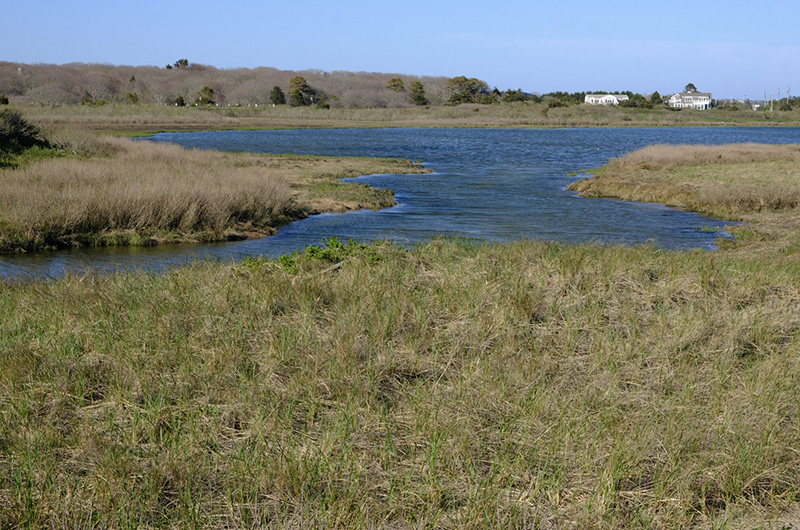More than half the nitrogen polluting Great Ponds along the south shore of Martha’s Vineyard is coming from wastewater, a newly released report by a team of Woods Hole scientists has found.
Commissioned by the nonprofit Great Pond Foundation, the study by the team at the Marine Biological Laboratory was able to pinpoint sources of nitrogen for the first time, using stable isotope-tracking technology to analyze water and benthic (bottom sediment) samples taken last year.

The study analyzed wastewater, fertilizer and naturally occurring atmospheric deposits — three major external sources of nitrogen — in Edgartown Great Pond, Crackatuxet Cove, Chilmark Pond and Tisbury Great Pond.
Sampling was done between June and October 2021. In every pond, well over half the nitrogen in the samples was coming from wastewater, likely traced to septic systems, the isotope study found.
While the three down Island towns have municipal sewer systems that connect some businesses and residences to a central wastewater treatment plant, most Island homes outside the main population centers rely on individual septic systems.
In Edgartown Great Pond 55 per cent of the nitrogen was tracked to wastewater. In Chilmark Pond 58 per cent of the nitrogen was coming from wastewater. In Tisbury Great Pond the number was 53 per cent. In Crackatuxet, a closed cove adjacent to the Edgartown Great Pond, the number was 51 per cent. The remainder was split between fertilizer and atmospheric deposits, with fertilizer accounting for roughly 24 per cent of nitrogen in Chilmark Pond, and 27 per cent in Tisbury Great Pond, for example.
The results begin to bring new clarity to what until now has mainly been a subject for speculation: the source of nitrogen in the ponds.
“Is it wastewater? Is it fertilizer? Is it atmospheric?” said Emily Reddington, executive director of the Great Pond Foundation, a privately funded nonprofit based in Edgartown. “These ponds are an essential way of life on Martha’s Vineyard. We know nitrogen is an issue . . . now we have learned that more than half the nitrogen is coming from wastewater. Which means if we reduce the nitrogen we’re going to be able to save our ponds.”
The study was published Wednesday on the Great Pond Foundation’s website. The authors are Javier Lloret, Anne Giblin and Rich McHorney, research scientists at The Ecosystems Center for the Marine Biological Laboratory.
“This all stems from the interest of the Great Pond Foundation trying to figure out what’s going on with the Island ponds and how to improve some of the conditions,” Mr. Lloret said, speaking to the Gazette by phone.
Explaining the technology used in the study, he said the stable isotopes act as tracers on plankton, invertebrates and other marine organisms that live in the ponds. “This is very important in terms of management,” Mr. Lloret said. “We can try to model things and quantify how much is entering the ponds, but . . . with these tools you have a direct measurement that you can link to the sources.”
Atmospheric nitrogen occurs naturally in the environment, he said.
“Wastewater nitrogen is coming from septic mostly. Fertilizer is coming from agriculture and also our lawns,” he added. “These three sources have very different and distinct isotopic signatures.”
The isotope technology is not new, Mr. Lloret said. “It is widely used, but not something you would find every time you are in a location that has a problem with nitrogen pollution,” he said. He continued:

“According to the calculations we performed, you can conclude that more than half the nitrogen that is entering the pond and being used by the biological community . . . is from wastewater. And it’s not just nitrogen traveling through — it is entering the ecosystem.”
He said in some of the samples that were analyzed the number was as high as 80 per cent.
The study comes at a pivotal time on the Vineyard, with water quality research and planning actively taking place on a number of fronts amid heightened concern about the polluting effects of overdevelopment, especially from subsurface sewage disposal.
Edgartown, Tisbury and Oak Bluffs are all in various stages of completing comprehensive wastewater management plans, aimed at upgrading sewage treatment plants that are at or near capacity. The Martha’s Vineyard Commission is using grant money to develop a watershed management plan for the up-Island towns, which have no sewage treatment facilities. An MVC report on the Tisbury Great Pond was recently released; the Great Pond Foundation plans to release its own report for the same pond in June. Privately-funded collaborative pond associations have also formed for Tisbury and Chilmark ponds. Even farther back in time, the Massachusetts Estuaries Project — a public-private effort involving scientists at the University of Massachusetts at Dartmouth and the state Department of Environmental Protection — has been collecting data and analyzing water quality in ponds and embayments here since the early 2000s.
With such a large volume of information amassed — and more coming — and so much work crossing government and private sectors, enacting policy has been more difficult. But Ms. Reddington said the outlook is positive, especially because while the ponds are impaired by nitrogen to varying degrees, most still host healthy ecosystems.
“There is still hope. We have this incredible opportunity to preserve the ponds,” Ms. Reddington said. “And there is more science and technology emerging on how to fix them.”
The Edgartown Great Pond is one example of a partial success story that she believes is a direct result of active management that includes regular dredging in concert with cutting the pond open to the sea.
Today the pond hosts some five acres of eelgrass, an aquatic plant essential to a healthy ecosystem for bay scallops and other shellfish populations. Once found in abundance in all the Island ponds, in recent decades eelgrass, which is sensitive to pollution, has been dying off at a rapid rate, alarming biologists.
Just this week the Edgartown select board approved a commercial softshell clam season for the Edgartown Great Pond, a cottage shellfish industry that has seen a revival only in the last two years.
Ms. Reddington said records kept by the state Division of Marine Fisheries show an encouraging pattern of increasing salinity in the pond in recent years.
The MBL isotope study appears to validate the benefits of pond openings for reducing nitrogen. “Wastewater contributions were larger during June and July, high in August, but decreased substantially in October,” scientists wrote. “This decrease could potentially be linked to the opening of the inlet on August 7, and the re-establishment of the connection with the sea that could have helped flush away some of the excess nitrogen in the pond.” They continued: “Our samples from August 10, only three days after the reopening of the inlet, did not seem to reflect much of an effect . . . indicating that the flushing of nutrients and subsequent measurable response . . . could take several days or even weeks.”
The practice of opening Great Ponds to the sea is in fact more than a century old and rooted in an arcane state statute enacted in 1904. The law allows “the proprietors of low lands and meadows around any great pond in the county of Dukes County . . . to organize . . . [and] do or cause to be done whatever may be necessary to properly drain the low lands and meadows . . .”
The old law makes an explicit exception for the Edgartown Great Pond. As a result, today that pond is managed by the town, while other ponds are managed by riparian owners.
Ms. Reddington said some believe the exception was due to the lucrative herring fishery at Mattakesett Creek, which had economic importance for the commonwealth at the time.
The isotope study also did some limited sampling of the Mill Brook, a freshwater river system that flows into the Tisbury Great Pond at its northern end. That analysis found fertilizer, not wastewater, was the primary contributor of nitrogen.

“This fact probably confirms that this stream is not a major source of wastewater nitrogen to the Tisbury Great Pond,” scientists wrote, adding: “The low wastewater and relatively high fertilizer contributions [are] consistent with the relatively undeveloped land and presences of small farms.”
The study did only limited analysis of nitrogen from birds, Mr. Lloret said. He explained further that despite widespread perception that migratory waterfowl are large contributors to nitrogen in ponds, more than one credible study has found that waterfowl contribute only trace amounts of nitrogen to saltwater estuaries, for various reasons.
The privately-funded isotope study cost betwen $50,000 and $100,000, Ms. Reddington said.
A second phase of the study is now planned that will aim to more closely identify locations of origin for the wastewater.
“The first year was almost like a pilot project to see the potential there for future ongoing work,” Mr. Lloret said. “Now we have increased our efforts — we are going to not only continue to collect samples and do isotopic analysis, we are also going to try to pinpoint the location of where the nitrogen is coming from.” Among other things, that work will involve sampling groundwater at the edge of the pond where it enters the estuary.
It’s like detective work, he agreed.
“You just need to follow the clues. The isotopes will be like the fingerprints, and that’s how we use them.”







Comments (10)
Comments
Comment policy »